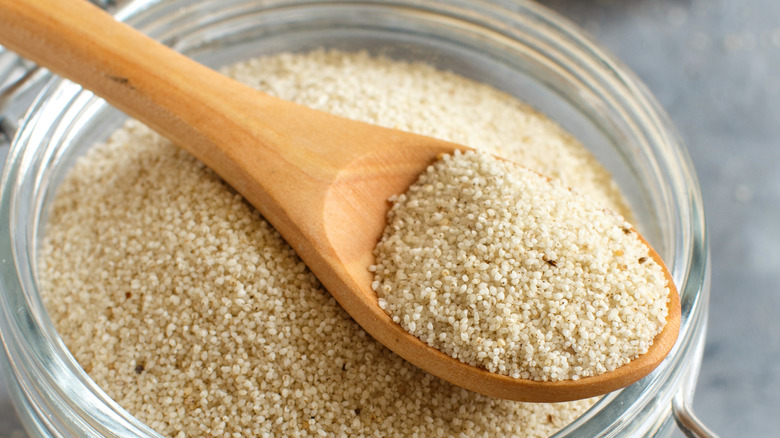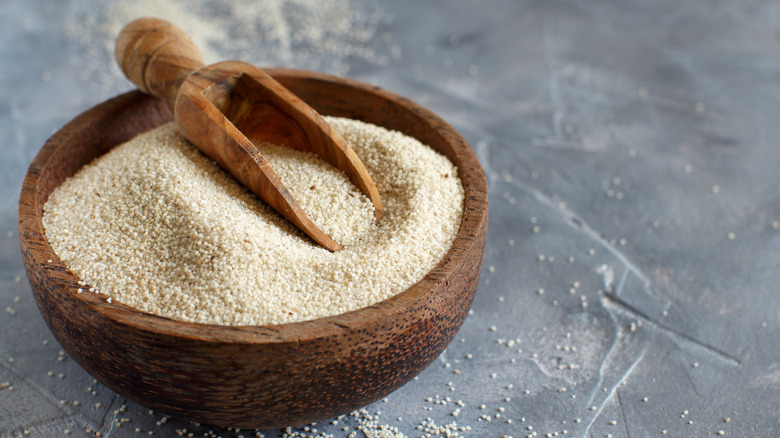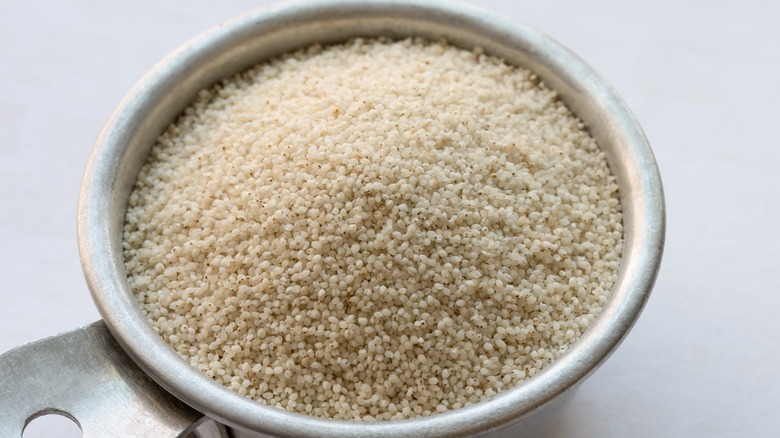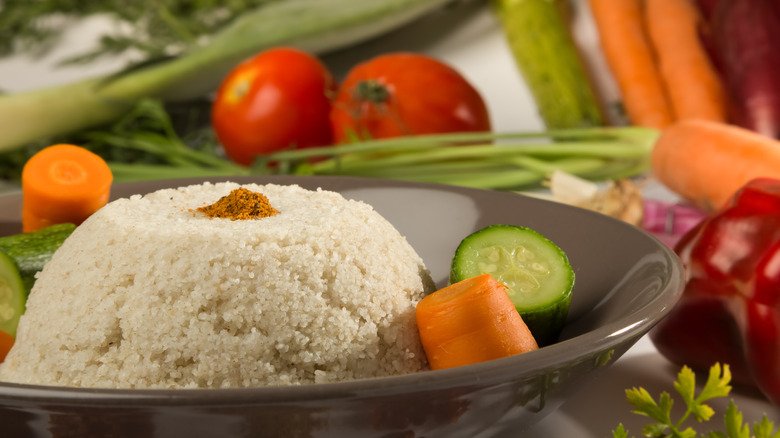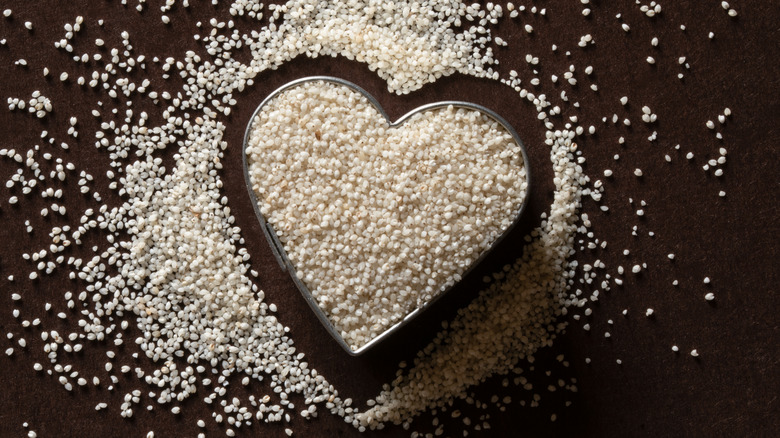Fonio: The West African Grain You Should Pay Attention To
We may receive a commission on purchases made from links.
According to the Whole Grains Council, ancient grains are whole grains that are grown and cultivated in the same way as when they were first discovered, remaining unprocessed and unrefined since they have existed. As their name implies, ancient grains have been around for a long time, but they have been recognized in the past decade for potential health benefits. Because ancient grains are unrefined, they offer better nutritional value than refined grains such as white flour.
Ancient grains are excellent sources of fiber and are high in zinc, omega-3 fatty acids, vitamin B, and protein (via Health Matters). Each ancient grain has its own health benefits, but because of their high fiber content, they all help with digestion and help control blood sugar levels. You may have heard of popular ancient grains like quinoa, barley, farro, spelt, sorghum, amaranth, blue corn, and buckwheat. But there are many lesser-known varieties. One that's gaining more traction is called fonio (Digitaria exilis). Here's everything you need to know about fonio.
What is fonio?
According to a TED talk by Senegalese chef Pierre Thiam, fonio is an ancient grain grown in the Sahel region of West Africa, which includes countries south of the Sahara desert, such as Senegal, Burkina Faso, Mali, Nigeria, and Togo. Thiam says that fonio is "probably the oldest cultivated cereal in Africa" and "had been cultivated for more than 5,000 years." Fonio was so popular and cherished at one time that some ancient Egyptians were actually buried in pyramids with the ancient grain. Healthline notes that fonio was seen as a holy, royal food and was only served during Ramadan, baptisms, weddings, and for royalty and chiefs.
A resilient crop, fonio can grow in almost any condition. Rather than being planted in rows, its seeds are sprinkled on the ground and topped with a layer of branches (per Bioversity International). Although the ancient grain favors rainy weather, it can also grow in unexpected conditions, such as rocky or sandy soil that's shallow or of poor quality. As one of the fastest-growing ancient grains, fonio can be harvested about 60 to 120 days after seedlings emerge from the soil.
Bioversity International says that a big problem when harvesting fonio is that it breaks if not harvested at the right time. The grain itself is also very small, so harvesters had a hard time husking and threshing by hand. Today, there are machines that husk and process the fonio, making the process more efficient.
What does fonio taste like?
In his TED Talk, Chef Thiam describes fonio on its own as having a "delicate taste" and being "similar to couscous [with a] nutty, earthy flavor." Before cooking, fonio is very small and may remind you of sand, cornmeal, or finely crushed breadcrumbs. According to Yolele, fonio is "light and fluffy" when cooked and is able to "soak up spices and sauces beautifully, making it a perfect base to just about anything."
Because it's an ideal base for any meal, it will take on the flavor of whatever it's served with while also adding its own subtle nutty flavor and complementing the dish. Chef Thiam says in his cookbook, "At Mamma's, we ate fonio the way others would eat rice. She often served it steamed, accompanied with a variety of offerings: a freshly pounded, bright red palm nut sauce; a generous and creamy peanut and root vegetable topping; a rich caramelized onion and lime relish; a red palm oil and sweet potato leaves stew; or a gooey okra sauce with lamb, fish, seafood, or vegetables."
How to cook with fonio
Fonio doesn't take long to cook, and there are endless ways to incorporate the ancient grain into everyday meals. For Thiam's own Yolele brand of fonio, coat a half cup of fonio with oil and add it to a pot with one cup of water. Bring it to a boil, add salt if desired, and cover it for one minute. After that time is over, take it off the heat but leave it covered for four minutes. Just like rice, couscous, and quinoa, be sure to fluff it with a fork once it's done, and you're ready to experience West Africa's ancient grain. Fonio can also be prepared in a microwave using the same measurements but heated for two minutes, then left to rest for two minutes before serving.
At his TED Talk, Thiam serves the audience some sushi made with fonio, sweet potato, okra, cucumber, and carrots. He also says the fonio can be used in baking and replace any grain in any recipe. It may also be used as a topping for salad and used to make noodles and pasta. You can also find tons of fonio recipes on Yolele's website, such as blueberry fonio mini cupcakes, fonio mushroom risotto, frosted fonio pumpkin cookies, fonio veggie sliders, fonio peach porridge, pimento cheese fonio grits, and way more.
Where to buy fonio
While fonio is gaining some popularity, the ancient grain is still somewhat tricky to find in grocery stores. Some Whole Foods, Fresh Market, and Target locations, as well as local specialty natural and health food stores, may carry fonio. However, if you have difficulty finding it in-store, fonio is available to order online through Amazon, Thrive Market, Yolele, and more (via Yolele).
There are a few things you can look out for when buying fonio. The first thing is finding organic, non-genetically modified fonio. Because fonio is an ancient grain, it should not be altered with GMOs anyway, but some producers may sell fonio that's not the real deal. You can also aim to purchase fonio that is sustainably sourced and Fair Trade certified. Fair Trade-certified products let the buyer know that the farmers and workers that produce the products work under safe conditions and receive fair wages (via Fair Trade).
Nutritional information about fonio
Per Yolele, fonio contains zinc, iron, magnesium, vitamin B, antioxidant properties, and amino acids methionine and cysteine, giving it a "similar amino acid composition to that of an egg." No other ancient grain contains these two amino acids, which encourage the healthy growth and function of nails, skin, and hair. Fonio is also gluten-free, low glycemic, and low-calorie. This makes fonio a great option for people with gluten allergies or celiac disease and those with diabetes or high blood sugar. While one cup of pasta has 220 calories and one cup of quinoa has 222 calories, one cup of fonio only has around 140 calories.
According to Healthline, fonio also contains copper, which helps support blood cells, connective tissue, and red blood cells, along with iron. Zinc aids in maintaining a healthy immune system, cell formation, and protein synthesis, while magnesium helps the body have enough energy throughout the day. Fonio may also support a healthy gut and weight, as well as minimize risks of heart disease, type 2 diabetes, and several cancers such as stomach, colorectal, and pancreatic. Fonio was also used to help women during and after childbirth to encourage breast milk production and to counteract blood clotting. One thing to be aware of is that fonio has certain flavonoids that may have antithyroid properties, so individuals with certain conditions may want to limit how much fonio they consume (via Verywell Fit).
